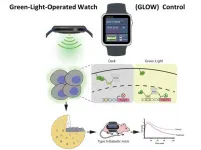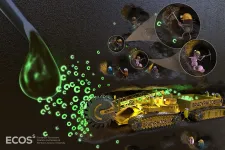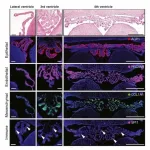(Press-News.org) Many modern fitness trackers and smartwatches feature integrated LEDs. The green light emitted, whether continuous or pulsed, penetrates the skin and can be used to measure the wearer's heart rate during physical activity or while at rest.
These watches have become extremely popular. A team of ETH researchers now wants to capitalise on that popularity by using the LEDs to control genes and change the behaviour of cells through the skin. The team is led by Martin Fussenegger from the Department of Biosystems Science and Engineering in Basel. He explains the challenge to this undertaking: "No naturally occurring molecular system in human cells responds to green light, so we had to build something new."
Green light from the smartwatch activates the gene
The ETH professor and his colleagues ultimately developed a molecular switch that, once implanted, can be activated by the green light of a smartwatch.
The switch is linked to a gene network that the researchers introduced into human cells. As is customary, they used HEK 293 cells for the prototype. Depending on the configuration of this network - in other words, the genes it contains - it can produce insulin or other substances as soon as the cells are exposed to green light. Turning the light off inactivates the switch and halts the process.
Standard software
As they used the standard smartwatch software, there was no need for the researchers to develop dedicated programs. During their tests, they turned the green light on by starting the running app. "Off-the-shelf watches offer a universal solution to flip the molecular switch," Fussenegger says. New models emit light pulses, which are even better suited to keeping the gene network running.
The molecular switch is more complicated, however. A molecule complex was integrated into the membrane of the cells and linked to a connecting piece, similar to the coupling of a railway carriage. As soon as green light is emitted, the component that projects into the cell becomes detached and is transported to the cell nucleus where it triggers an insulin-producing gene. When the green light is extinguished, the detached piece reconnects with its counterpart embedded in the membrane.
Controlling implants with wearables
The researchers tested their system on both pork rind and live mice by implanting the appropriate cells into them and strapping a smartwatch on like a rucksack. Opening the watch's running program, the researchers turned on the green light to activate the cascade.
"It's the first time that an implant of this kind has been operated using commercially available, smart electronic devices - known as wearables because they are worn directly on the skin," the ETH professor says. Most watches emit green light, a practical basis for a potential application as there is no need for users to purchase a special device.
According to Fussenegger, however, it seems unlikely that this technology will enter clinical practice for at least another ten years. The cells used in this prototype would have to be replaced by the user's own cells. Moreover, the system has to go through the clinical phases before it can be approved, meaning major regulatory hurdles. "To date, only very few cell therapies have been approved," Fussenegger says.
INFORMATION:
Reference
Mansouri M, Hussherr M-D, Strittmatter T, Buchmann P, Xue S, Camenisch G, Fussenegger M: Smart-watch-programmed green-light-operated percutaneous control of therapeutic transgenes. Nature Communications, 2021, 7 June; doi: 10.1038/s41467-021-23572-4
Levels of a protein called neurofilament light chain (NfL) in the blood can identify those who might have neurodegenerative diseases such as Down's syndrome dementia, motor neuron disease (ALS) and frontotemporal dementia, when clinical symptoms are not definitive.
Published in Nature Communications and part-funded by the NIHR Maudsley Biomedical Research Centre, the research determined a set of age-related cut-off levels of NfL which could inform its potential use in primary care settings through a simple blood test.
Joint Senior Author on the study, Dr Abdul Hye from the NIHR Maudsley Biomedical Research Centre at King's College London and South London and Maudsley NHS Foundation Trust said: 'For the first time we have shown ...
The first double-blind experiment analysing the role of human decision-making in climate reconstructions has found that it can lead to substantially different results.
The experiment, designed and run by researchers from the University of Cambridge, had multiple research groups from around the world use the same raw tree-ring data to reconstruct temperature changes over the past 2,000 years.
While each of the reconstructions clearly showed that recent warming due to anthropogenic climate change is unprecedented in the past two thousand years, there were notable differences in variance, amplitude and sensitivity, ...
NEW YORK, June 7, 2021--Recent studies suggest that new brain cells are being formed every day in response to injury, physical exercise, and mental stimulation. Glial cells, and in particular the ones called oligodendrocyte progenitors, are highly responsive to external signals and injuries. They can detect changes in the nervous system and form new myelin, which wraps around nerves and provides metabolic support and accurate transmission of electrical signals. As we age, however, less myelin is formed in response to external signals, and this progressive decline has been linked to the age-related cognitive and motor deficits detected in older people in the general population. Impaired ...
Just a few bacterial taxa found in ecosystems across the planet are responsible for more than half of carbon cycling in soils. These new findings, made by researchers at Northern Arizona University and published in END ...
In a white ocean, well above sea level, the algae thrive. Normally invisible to the naked eye, they are often spotted by hikers trekking through the mountains in late spring as strikingly coloured stretches of snow, in shades of ochre, orange and red. Known as "glacier blood", this colouring is the result of the punctual multiplication (or bloom) of the microalgae that inhabit the snow.
But apart from this impressive phenomenon, the life and organisation of mountain microalgae communities remains a secret. It is this still unknown ecosystem, now threatened by global warming, that needs to be explored. The ALPALGA* consortium aims to meet this challenge by organising and pooling research efforts on snow microalgae, and it has already received support from the Agence nationale ...
Mental health visits for new mothers were 30% higher during the COVID-19 pandemic than before the pandemic, particularly in the first 3 months after giving birth, found new research in CMAJ (Canadian Medical Association Journal). https://www.cmaj.ca/lookup/doi/10.1503/cmaj.210151
"Increased visit rates began in March 2020, although the state of emergency was declared only midway through the month, suggesting that distress related to the pandemic translated into an increased need for care very quickly," writes Dr. Simone Vigod, chief of psychiatry, senior scientist and interim vice president of academics at Women's College Hospital (WCH), and senior adjunct scientist at ...
New research indicates that patients hospitalized with active cancer were more likely to die from COVID-19 than those with a history of cancer or those without any cancer diagnosis. The findings published by END ...
A traditional Vietnamese meat snack could hold the key to developing a safe and natural food preservative, addressing the twin global problems of food waste and food-borne illnesses.
Key Points
Bacteria-killing compound discovered in Nem Chua, a fermented pork snack
Toxic to bacteria but safe for humans, it's a natural alternative to artificial food preservatives
New study reveals ideal growth conditions to potentially make the bacteria-killer at industrial scales
The fermented pork snack, Nem Chua, is eaten raw but does not cause food poisoning when prepared correctly.
This is because friendly bacteria that thrive in the fermented meat make a special compound that destroys more dangerous bacteria.
Now ...
Once viewed merely as a producer of the cerebrospinal fluid (CSF) bathing the brain and spinal cord, the choroid plexus is now known to be a key player in brain development and immunity. These fronds of brain tissue, located in the CSF-filled brain cavities known as ventricles, secrete instructive cues into the CSF to regulate brain development. They also function as an important barrier between the brain and the rest of the body.
Maria Lehtinen, PhD, of Boston Children's Hospital has done much of the pioneering work in understanding this once-obscure tissue. In new work published in Cell, Lehtinen, Neil Dani, PhD, and other colleagues at Boston Children's and the Broad Institute created ...
The friendship paradox is the observation that the degrees of the neighbors of a node within any network will, on average, be greater than the degree of the node itself. In other words: your friends probably have more friends than you do.
While the standard framing of the friendship paradox is essentially about averages, significant variations occur too.
In the Journal of Complex Networks, Santa Fe Institute and University of Michigan researchers George Cantwell, Alec Kirkley, and Mark Newman address this by developing the mathematical theory ...




